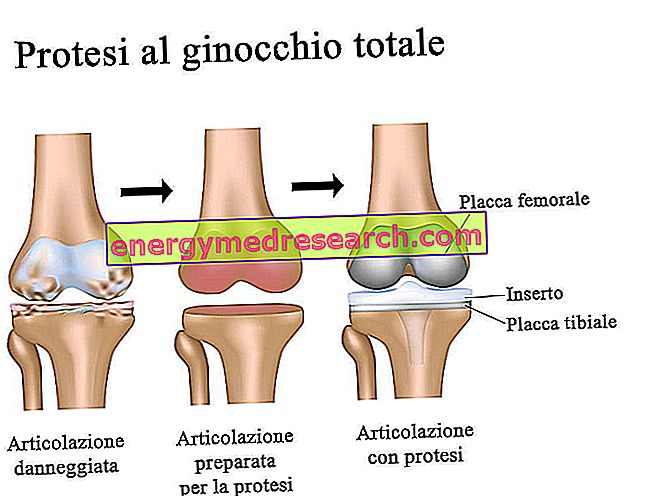Generality
Tension headache is the most common form of headache and, relatively, the least painful.

The tension headache is more common in the female sex and it mainly affects people who spend a lot of time sitting in incorrect positions or accumulate stress .
Also bad dental occlusion, lack of rest, cervicalgia and asthenopia (visual fatigue) can contribute to the appearance of tension-type headache. The disorder can also be related to depression or anxiety: currently, a form of headache has been recognized that is not associated with muscular tension, and therefore probably only of psychological origin .
Tension headache often has variable characteristics in the same person who tends to suffer from it. In many cases, however, this form of headache causes a persistent pain, of mild or medium intensity, which is localized in the occipital region, ie in the posterior part of the skull, above the nape. In some subjects, on the other hand, constrictive pain (often referred to as a "circle in the head") concentrates mainly at the level of the eyes and temples (frontal region), or is spread throughout the head. The tension headache is frequently bilateral, ie it affects both the right and left sides.
Pain attacks can last from half an hour to 5-7 days.
Tension headache can be episodic or chronic (if seizures occur every two to three days). This form of headache does not involve other symptoms, such as functional disability, nausea or aversion to light (photophobia), which are typically associated with migraine. Furthermore, tension-type headache does not affect the patient's normal daily activities and movement seems to help alleviate the disorder.
To adequately manage this form of headache, it is necessary to identify and treat potential triggers.
Causes and triggers
The tension headache affects up to 75% of the population, with a greater prevalence in the female sex.
The causes of the disorder are not entirely known, but most specialists agree that this form of headache depends on an involuntary and continuous contraction of the muscles of the neck, forehead, temples, neck and shoulders. The tension headache is in fact more common in people who, for study or work reasons, tend to assume an incorrect position (more unbalanced forward); this forces you to tighten your neck and head muscles more, to find the ideal balance.
At the origin of this form of headache, however, there may also be more strictly neurological causes, such as alterations of the brain centers that control the perception of pain and tolerance to stress.
The main factors triggering tension headaches are stressful events, nervous disturbance, anxiety and depression; therefore, the condition is often considered a psychosomatic disorder . Not surprisingly, people who find themselves in these situations tend to discharge the accumulated tension at shoulder level, by contracting the muscles of the neck and head; this involuntary but continuous effort results in an attack of headache.
Furthermore, it must be considered that the subjects who are going through a period of psychophysical exhaustion have a lower pain threshold than the average, due to the decrease in the level of endorphins. If the level of these substances is low, even a simple muscle contraction can be felt more painfully and intensely.
In addition to stress, the other factors that trigger the tension headache include:
- Bad postures that favor the continuous tension of the neck muscles;
- Drug abuse, which is addictive;
- Problems with the jaw joint;
- Hormonal imbalances;
- Changes in the sleep-wake rhythm.
Symptoms
Tension headache is characterized by mild or moderate pain, often described as constricting . The headache is persistent and not pulsating .
This form of headache originates in the occipital (nape) or frontal (temples and forehead) region and spreads to the whole head : the disorder manifests itself as a sense of heaviness or a vice that tightens the head, giving rise to the famous "circle" or "band".
Unlike migraine, tense headaches are not accompanied by functional disability, nausea or aversion to light (photophobia), and are not aggravated by physical activity, light stimuli, sounds or odors.
Potential triggers for chronic tension-type headache include sleep disturbance, stress, temporomandibular joint dysfunction, asthenopia and neck pain.
As a rule, headache attacks start several hours after waking up and get worse during the day; rarely, patients wake up from sleep.
Chronic forms can vary in intensity throughout the day, but are almost always present.
Frequency
The tension headache can be episodic or chronic .
In the first case, headache crises occur for less than 15 days a month. Episodic tension headache is very frequent; most patients take relief from over-the-counter analgesics and do not seek medical attention.
In chronic tension headache, on the other hand, the headache manifests itself, for at least six months a year, for more than 15 days a month.
Duration of an episode
The duration of the crises is very variable. In episodic forms, the tension headache manifests itself for a period ranging from 30 minutes to 7 days. Chronic tension headache can last instead, hours, days, weeks, months or years and be continuous.
In the milder forms, the disorder often arises in stressful situations, while in the more severe and chronic ones the pain usually appears in the morning on waking and continues until evening.
Possible associated symptoms
Other symptoms that can be associated with tension headache can be: tenderness of the pericranial muscles (regulate the movement of the jaw) and anxiety manifestations. Rarely, vomiting and nausea appear.
Diagnosis
The diagnosis of tension headache is based on the characteristic symptoms and the negativity of clinical objectivity (including neurological).
The most appropriate measures to counteract the tension headache must be indicated by the doctor, who must first gather some information on the presentation of the disorder (medical history), including:
- Seat of pain (unilateral, bilateral, frontal, occipital, etc.);
- Gravity (mild, moderate, severe or debilitating) and quality of headache (constrictive, pulsating, intermittent, constant, oppressive or stabbing);
- Mode of occurrence (eg sudden or gradual);
- Duration of painful crises and times in which they occur;
- Any concomitant symptoms;
- Lack of rest or activities that may have contributed to the onset of pain (eg following physical exertion or having maintained a particular posture for a long time).
For recurrent tension headache episodes, the following should be investigated:
- Age of onset;
- Frequency of episodes and temporal references according to specific situations (such as, for example, the possible correlation with a phase of the menstrual cycle);
- Response to treatments (including over-the-counter drugs).
To facilitate the formulation of the diagnosis of tension-type headache, it may then be useful to compile a " headache diary ", in order to help your doctor better understand which situations more easily predispose to headaches (eg activities turns, food consumed and any medications taken before its appearance) and the progress of attacks over time.
The compilation of this sort of register also makes it possible to monitor and determine the effectiveness of any therapeutic approach undertaken.
Diagnostic imaging
If the patient has an unusual headache, complicated or refractory to therapy, to rule out other causes of tension headache or more serious pathological conditions, the doctor may indicate further investigations, such as, for example:
- Computed tomography and magnetic resonance : allow the exclusion of benign or malignant expansive lesions, such as a pituitary adenoma or a brain neoplasm.
- The lumbar puncture (or rachicentesi, a technique that involves the extraction of the cerebrospinal fluid) is performed to obtain the differential diagnosis with respect to conditions such as an infection, a meningitis or another neurological condition.
Treatment
To limit the frequency of attacks of tension headache, it is good to intervene on the triggering factors, both by taking drugs and by correcting any incorrect behavior.
For most mild to moderate tensive forms, analgesics (such as paracetamol) and non-steroidal anti-inflammatory drugs (NSAIDs) are used, such as ibuprofen, naproxen, diclofenac and acetylsalicylic acid; these drugs help combat pain and provide relief.
Opiates or narcotics are rarely used, due to their side effects and the potential development of an addiction.
In some cases, the doctor may indicate the use of muscle relaxants, which decrease muscle contraction or, in the event that this form of headache is associated with particularly stressful events, anxiety and depressed mood, may prescribe anxiolytics . Even antidepressants (tricyclics or inhibitors of selective recovery of serotonin, SSRIs) can sometimes be used in the prevention of attacks of tension headache (to reduce their frequency and severity), especially if they occur with frequent or chronic headaches that are not relieved by other treatments.
Among the complementary therapies for this form of headache behavioral and psychological interventions can be helpful (eg cognitive-behavioral therapy and stress management techniques). Furthermore, biofeedback, which induces muscle relaxation through the use of electrodes, and massage therapy, a manual technique that can help reduce muscle tension, can help to manage tension headaches.
Yoga, like any other relaxation technique, has also been shown to be effective in tension headaches.
Practical advice and lifestyle
Prevention of tension headache or reduction in the frequency of attacks is possible by adopting a healthy lifestyle and respecting certain rules of behavior:
- Do not cure the headache with the "do it yourself": the treatment must always be established by the doctor. In particular, do not use analgesics and other over-the-counter drugs in an uncontrolled manner.
- Avoid conflicts, both at work and in the family, and all those situations that induce anxiety and stress, the main causes of tension headaches. To help reduce tension, it can be useful to plan and organize the day in advance. Furthermore, it is advisable to carve out time and space every day to dedicate to the activities you prefer, such as reading a book, enrolling in a dance course or watching TV.
- Respect the sleep-wake rhythm: sleeping excessively or too little in relation to one's needs is a factor that alters the general balance of the organism and can facilitate the onset of tension headache.
- Practicing a regular physical activity: sport helps to release stress and tension, promotes sleep and helps regulate biological rhythms. Attention, however, to physical efforts too intense.
- Check that the origin of the tension headache does not depend on problems with the jaw joint or dental anomalies; in this case, the intervention of the dentist is required.



